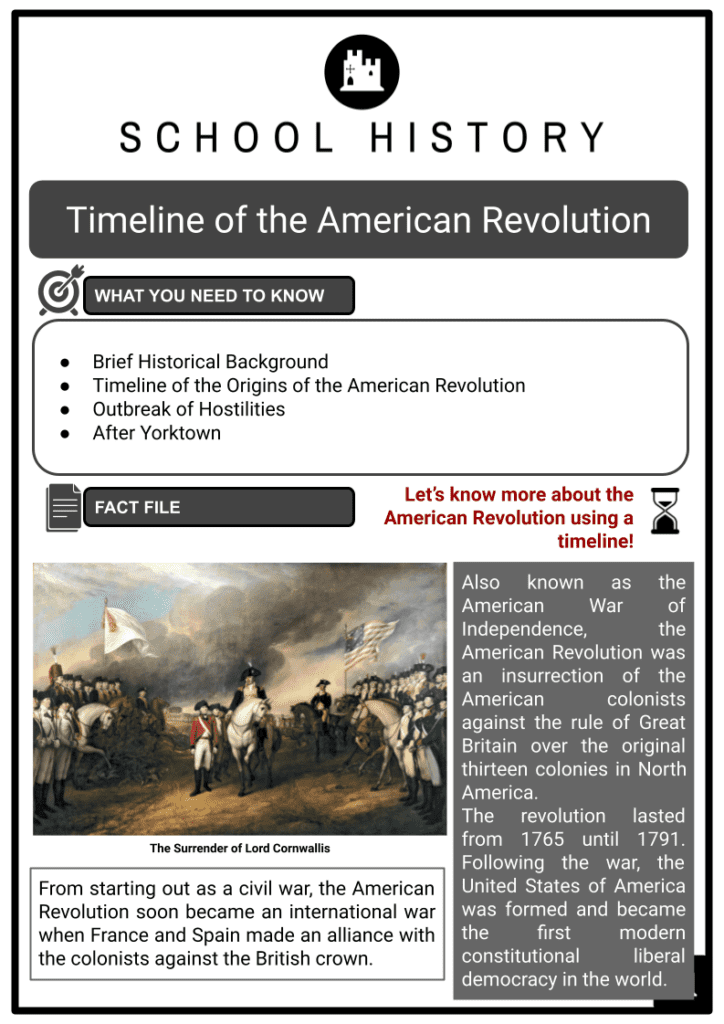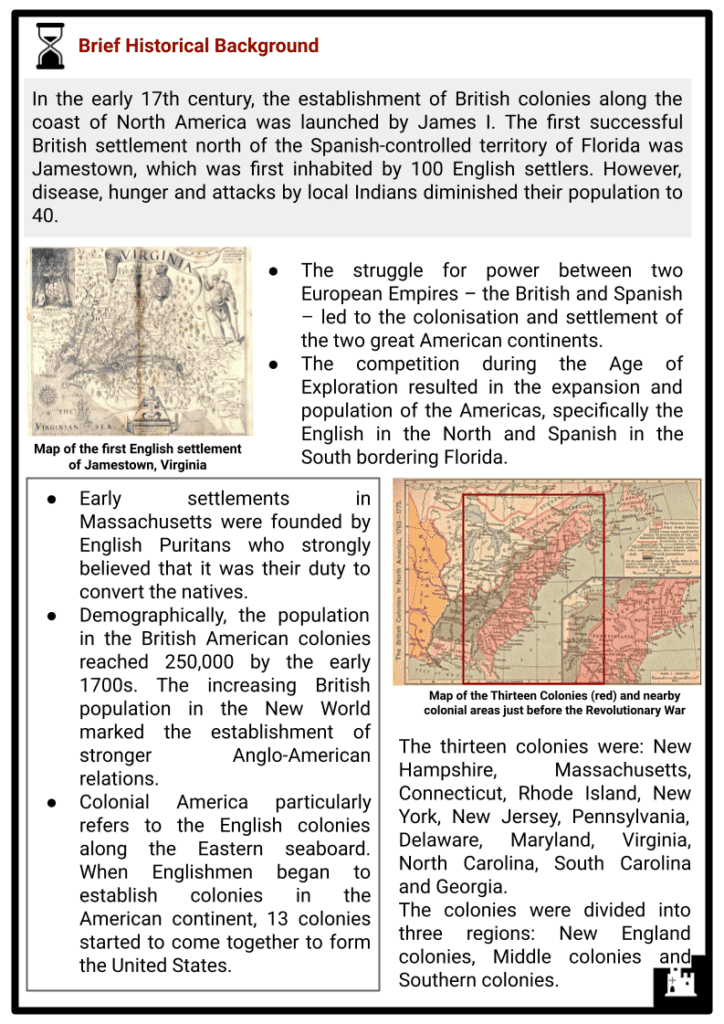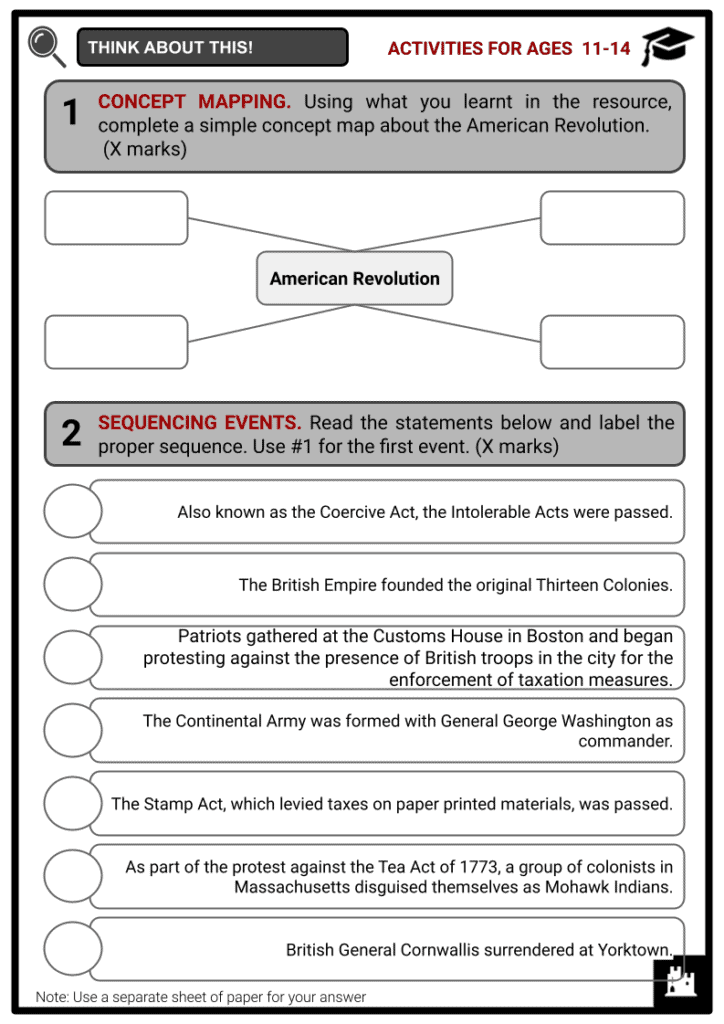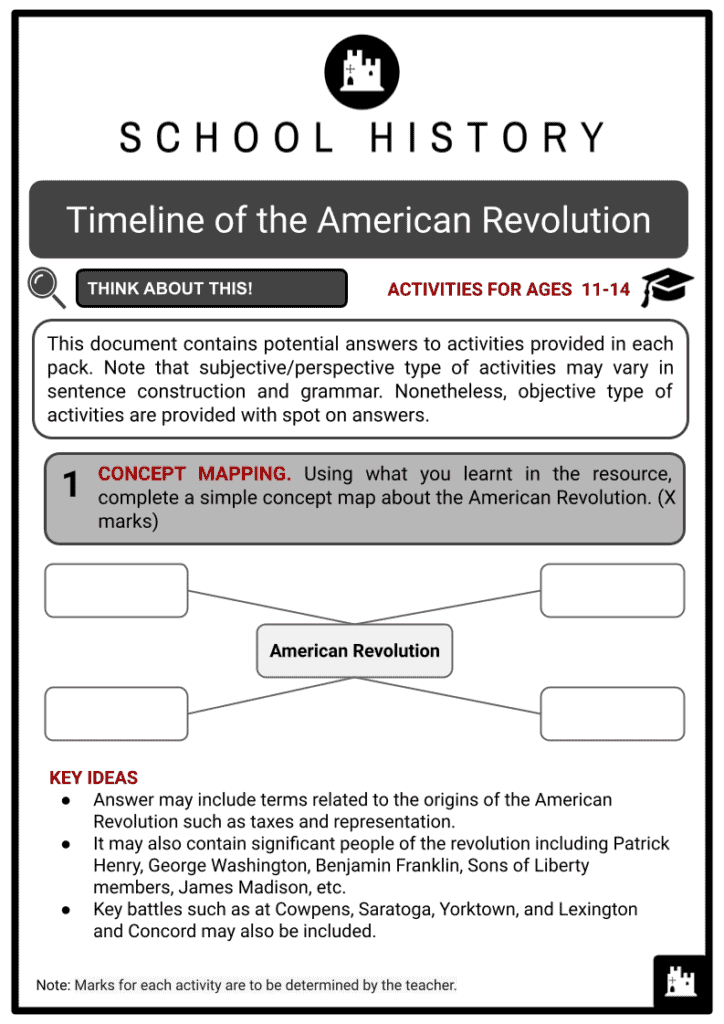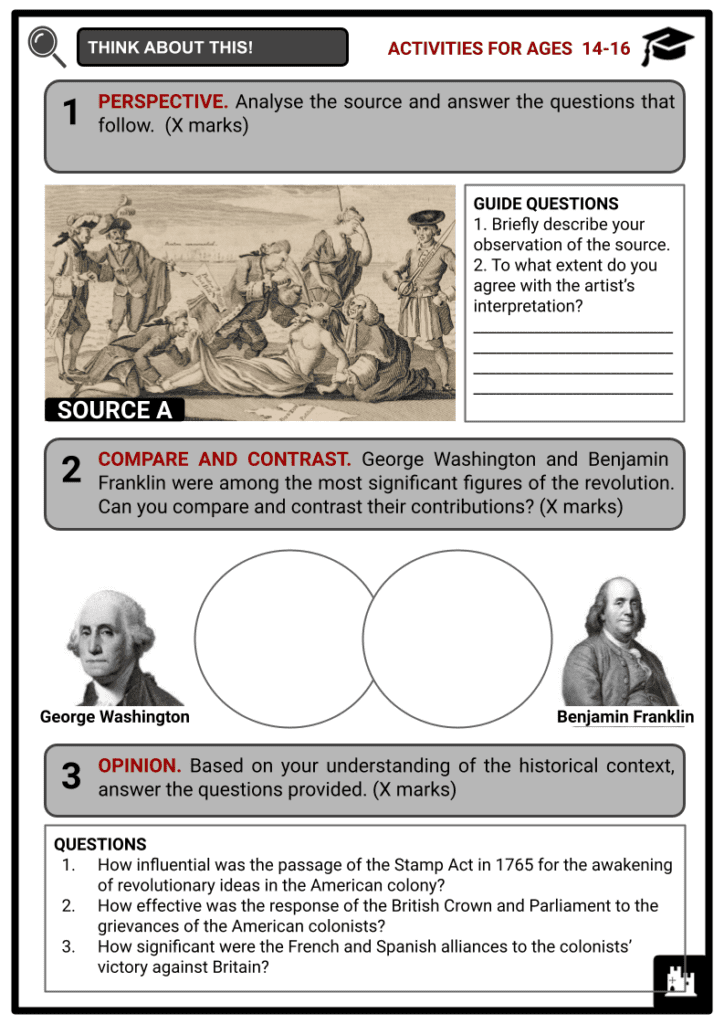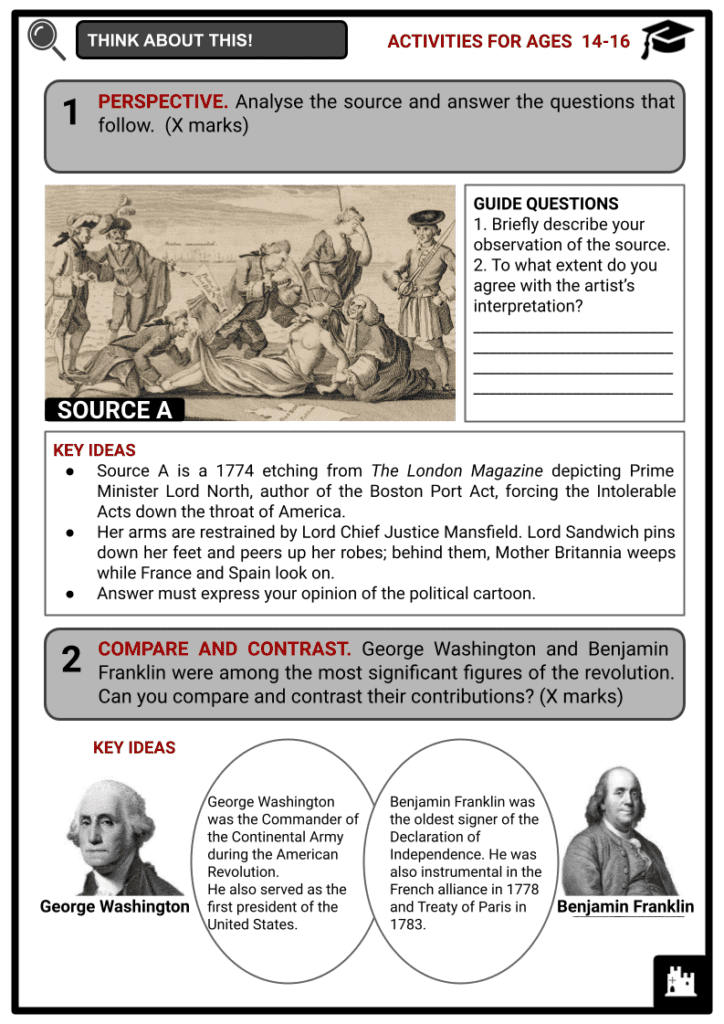Download The Timeline of the American Revolution
Do you want to save dozens of hours in time? Get your evenings and weekends back? Be able to teach The Timeline of the American Revolution to your students?
Our worksheet bundle includes a fact file and printable worksheets and student activities. Perfect for both the classroom and homeschooling!
Table of Contents
Add a header to begin generating the table of contents
Summary
- Brief Historical Background
- Timeline of the Origins of the American Revolution
- Outbreak of Hostilities
- After Yorktown
Key Facts And Information
Let’s find out more about the Timeline of the American Revolution!
- Also known as the American War of Independence, the American Revolution was an insurrection of the American colonists against the rule of Great Britain over the original thirteen colonies in North America.
- The revolution lasted from 1765 until 1791. Following the war, the United States of America was formed and became the first modern constitutional liberal democracy in the world.
- From starting out as a civil war, the American Revolution soon became an international war when France and Spain made an alliance with the colonists against the British crown.
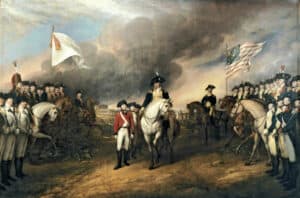
Brief Historical Background
- In the early 17th century, the establishment of British colonies along the coast of North America was launched by James I. The first successful British settlement north of the Spanish-controlled territory of Florida was Jamestown, which was first inhabited by 100 English settlers. However, disease, hunger and attacks by local Indians diminished their population to 40.
- The struggle for power between two European Empires – the British and Spanish – led to the colonisation and settlement of the two great American continents.
- The competition during the Age of Exploration resulted in the expansion and population of the Americas, specifically the English in the North and Spanish in the South bordering Florida.
- Early settlements in Massachusetts were founded by English Puritans who strongly believed that it was their duty to convert the natives.
- Demographically, the population in the British American colonies reached 250,000 by the early 1700s. The increasing British population in the New World marked the establishment of stronger Anglo-American relations.
- Colonial America particularly refers to the English colonies along the Eastern seaboard. When Englishmen began to establish colonies in the American continent, 13 colonies started to come together to form the United States.
- The thirteen colonies were: New Hampshire, Massachusetts, Connecticut, Rhode Island, New York, New Jersey, Pennsylvania, Delaware, Maryland, Virginia, North Carolina, South Carolina and Georgia.
- The colonies were divided into three regions: New England colonies, Middle colonies and Southern colonies.
Timeline of the Origins of the American Revolution
- In 1763, the British Crown issued a Proclamation Line, which kept colonists closer to English colonial authorities by confining them to the coast and which made the collection of taxes easier. However, the Proclamation Line enraged the colonists, who ignored it and settled westwards, creating new territories and overcoming challenges in the process and therefore becoming more self-reliant.
- The Proclamation Line also revealed some resentment the colonists had over the seven-year war. The colonists had over time begun to favour Native guerrilla warfare tactics. The British were overly formal and preferred more formal tactics of going to war.
- The New England colonies also disliked the fact that they had to house British troops during the war. However, the most pressing issue was Britain’s attempts to tax the colonists to pay for Britain’s wars.
- Furthermore, Britain had established an authoritarian rule over Canada, causing concerns in America over the loss of liberties in Canada.
- To the Crown, winning the war meant that the whole of the North American region was now free from their control and exploitation.
1765
- In March, the British Parliament passed further legislation, which imposed a tax on legal documents, newspapers, playing cards, handbills and other kinds of printed materials – the Stamp Act.
- Many felt violated by the Stamp Act. On 29 May 1765, the issue was raised at the Virginia House of Burgesses through the newly elected member, Patrick Henry. Known as the Virginia Resolves, Henry’s speech highlighted the liberties and immunities of Virginians as granted by King James I in the early 1700s.
- In October 1765, the Stamp Act Congress held in New York came up with the document The Declaration of Rights and Grievances, which raised 14 points of protest over the Stamp Act and additional petitions to the king and the British houses.
- In addition to the opposition in colonial assemblies to the Stamp Act, many colonists gathered in mobs. Many used patriotic names such as the Sons of Liberty and the Liberty Boys.
1766
- In March, the Stamp Act was repealed. However, the Parliament passed the Declaratory Act (also known as the American Colonies Act), which affirmed the right of the Parliament to pass and impose laws on the colonies.
1767
- In June, the Townshend Acts (named after its sponsor Charles Townshend), which placed duties on imported glass, tea, lead and paper, was passed. In order to control smuggling, the act was enforced with blank search warrants and writs of assistance. Like their protests against the Stamp Act, the Sons of Liberty also spread their beliefs against the Townshend Acts.
1770
- On 5 March 1770, a group of protesters called the Patriots gathered at the Customs House in Boston and began protesting against the presence of British troops in the city for the enforcement of taxation measures. Ordered by their captain, Thomas Preston, British troops guarded the Customs House.
- After the incident, British soldiers were put on trial. In December 1770, two British soldiers were found guilty of manslaughter.
As a result of the incident, the Sons of Liberty urged for the removal of British troops in Boston. It was Paul Revere, a patriot and member of the Sons of Liberty, who made the provocative engraving of the incident named by the Americans as the Boston Massacre. The British referred to it as the Incident on King Street.
1772
- The Gaspee Incident marked the first uprising against the British Crown’s authority in America that provoked the American Revolution. It happened on 10 June 1772 when the Sons of Liberty burned down the HMS Gaspée, one of the schooners of the British Empire.
- The event increased tensions between the British officials, who wanted to increase control over legitimate trade and smuggling to increase revenue, and the American colonists, who increasingly protested against British impositions that clashed with their colonies’ economic sustainability.
1773
- In May, the Tea Act was another measure imposed on the American colonies by the British Parliament. The act allowed the East India Company to monopolise the tea trade in colonial America by lowering the tax, thus addressing smuggled tea from the Dutch.
- As part of the protest against the Tea Act of 1773, a group of colonists in Massachusetts disguised as Mohawk Indians boarded merchant ships full of chests of tea and dumped them all into the harbour.
- On 16 December, the raid, then named the Boston Tea Party, was organised by Samuel Adams with about 60 members of the Sons of Liberty, after Thomas Hutchinson, Massachusetts Governor, refused to give in to the colonists’ demand to halt three tea ships from docking in the harbour.
1774
- In response to the destruction of millions of dollars worth of British tea, the Intolerable Acts, also known as the Coercive Acts, was passed in 1774.
- The Quebec Act extended the British territory in Canada to the south of Ohio Valley. Moreover, it also welcomed and recognised Catholicism in Quebec, which angered the American colonists who were predominantly Protestants.
- The Administration of Justice Act gave the governor the power to move capital trials against government officials to Great Britain. Many colonists felt it was a way for officials to escape being tried for their crimes.
- As a direct punishment, the Boston Port Act closed the port to all ships until proper payment was made by the colonists.
- After the incident, the Massachusetts Government Act installed a new governor to oversee the colony. Unlike other colonies, the power of the colonists in Massachusetts was taken away, as officials were directly appointed instead of elected. Moreover, it directed that town meetings could only be held once a year.
- The Quartering Act required the colonies to provide barracks for British soldiers. In the absence of barracks, they could occupy hotels, houses and barns.
- Many colonists believed that the Intolerable Acts took away some of their basic freedoms. However, such punishment from the British Parliament also united the colonies in their sentiments, which later led to the American Revolutionary War.
- In response to the Intolerable Acts passed by the British Parliament, delegates from the colonies convened at the First Continental Congress held at Carpenter’s Hall in Philadelphia. About 56 delegates from all the colonies except Georgia met from 5 September to 26 October 1774. Delegates were elected by the people to compose the colonial legislature.
- They sent a letter to King George III explaining the issues of the colonies. They demanded that the king repeal the Intolerable Acts or they would continue to boycott British goods. However, the king ignored their demands. After the British refused to meet their demands, another Congress was set to meet in May 1775.
Outbreak of Hostilities
1775
- On 10 May 1775, the Second Continental Congress met at the State House in Philadelphia, also known as the Independence Hall. Compared to the First Continental Congress, all colonies were represented, including Georgia. It was led by John Hancock and joined by new members like Thomas Jefferson and Benjamin Franklin.
- In April, the first shot was heard at Lexington and Concord in Massachusetts.
- In order to have its own militia, on 14 June 1775 the Continental Army was established with George Washington as its Commanding General.
- Applying a diplomatic approach, Congress sent the Olive Branch Petition to the Crown on 8 July of the same year.
- At the beginning of the war, the British strategy was to contain the American Revolution in Massachusetts and prevent it from spreading. Although a good plan, it was easier said than done as the British suffered a number of casualties during the Battle of Bunker Hill in June 1775.
1776
- On 27 February, a group of loyalists was defeated by a patriot army at the Battle of Moores Creek Bridge.
- Loyalists were American colonists who supported the British Crown, while patriots were colonists who were determined to gain independence from Britain.
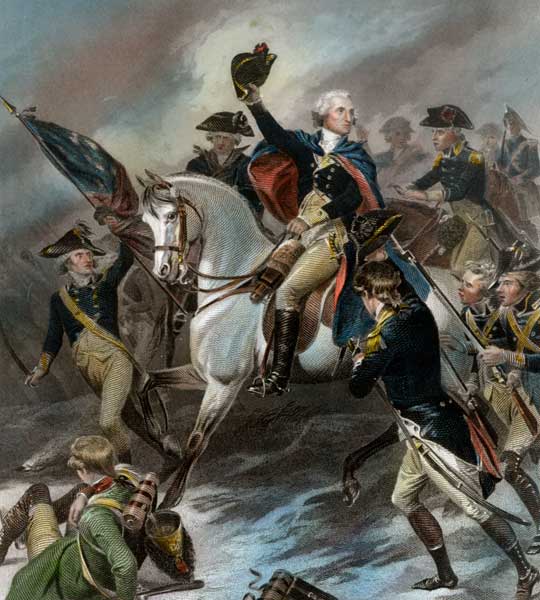
- In June, British troops attacked Sullivan’s Island in an attempt to subdue a patriot force. However, the waters of Charleston Harbour made it difficult. As a result, the British fleet retired, which kept South Carolina free from colonial troops.
- The colonists were frustrated with King George and Britain. Five men were selected to write a letter to King George. Four of the men were from the northern colonies. They were John Adams, Benjamin Franklin, Robert Livingston and Roger Sherman. One man, Thomas Jefferson, who was from the southern colony of Virginia, was asked to write the actual document due to his commended writing skills.
- Essentially, the Declaration of Independence declared war on King George and Great Britain. The document was signed by the Congressional Representatives of the Thirteen Colonies on 4 July 1776.
- The Declaration of Independence contained three important points the Congressional Representatives of the Thirteen Colonies wanted King George to know.
- Firstly, the documents told the king what they believed made good government.
- Secondly, it described which rules and taxes the representatives thought were unfair.
- The last statement the representatives included was to declare the colonies free and independent from Britain.
- After the letter was finalised, the Second Continental Congress made copies and distributed it to the people. Fifty-six men signed the Declaration of Independence.
- On Christmas Day, General Washington and his troops crossed the icy Delaware river into New Jersey.
- After the Battle in Trenton, Washington crossed the river again back to Pennsylvania. Before the end of the year, his troops crossed the river for the third time.
1777
- Burgoyne’s army arrived at a defenceless Fort Ticonderoga to prepare for a siege in July. Following the evacuation of the post by Arthur St. Clair, Britain was able to take the ‘American Gibraltar’ without resistance.
- In Skenesborough, known to be the ‘birthplace of the American Navy’, patriots made little effort to defend it from Burgoyne’s army.
- After finding out that Native Americans had joined their British allies, the patriots’ plan to hold Fort Anne was abandoned as defenders fled south to Fort Edward.
- Britain occupied Fort Edward as the Americans, led by Schuyler, abandoned the fort on 29 July and retreated down the Hudson River to Saratoga. Schuyler was then removed from his post by Congress on 4 August.
- Between September and October of 1777, two significant battles occurred in Saratoga. During these battles, the British force was composed of about 5,000 British Brunswickers, Canadians and Indians, while the American forces were militia 12,000 to 14,000-strong. General Burgoyne officially surrendered on 17 October 1777 and returned to England.
- In December 1777, the Continental Army spent the winter at Valley Forge, Pennsylvania. During their encampment, the army received aid and training from the French. Despite the winter, their supply arrangements improved.
1778
- In February, France made a formal alliance with the American colonists. The outcome of the Battle at Saratoga was pivotal in this alliance. The French provided the patriots military and financial aid, which became instrumental in winning the revolutionary war.
- In November, the Articles of Confederation were ratified by New Jersey.
1779
- Southern campaigns began. In 3 February, the British detachment at Port Royal Island, South Carolina was defeated. In 14 February, a group of loyalists was defeated at Kettle Creek.
- In June, Spain formally declared war against Britain.
1780
- In May, Charleston, South Carolina was captured by the British.
- In July, French troops arrived at Newport, Rhode Island in aid of the American colonists.
- By October, Washington appointed Nathanael Greene as Commander of the Southern Army.
1781
- In January, a British force at Cowpens was defeated by a patriot militia led by General Daniel Morgan.
- In March, the British had a costly victory against the Continental Army at Guilford Courthouse.
- Between May and June, the longest siege of the war took place at Ninety Six.
- In September, joint French-American troops laid siege at Yorktown, Virginia. After the British failure to send reinforcements, General Charles Cornwallis and his troops surrendered.
- The British surrender at Yorktown ended the American Revolutionary War.
After Yorktown
1782
- In March, Lord Frederick North resigned as prime minister of Britain. In the following months, British troops led Savannah, Georgia, and Charleston, South Carolina.
1783
- The preliminary peace treaty was ratified by the Congress in April. On 3 September, the Treaty of Paris, which formally ended the American Revolutionary War, was signed by the United States of America and Great Britain.
- A group of statesmen composed of John Adams, Benjamin Franklin, John Jay, Thomas Jefferson and Henry Laurens were sent by the Continental Congress to negotiate a peace treaty. However, only Adams, Franklin and Jay were able to negotiate. Laurens was captured and held captive in the Tower of London, while Jefferson failed to leave the United States.
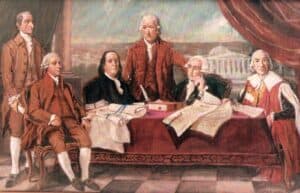
- During the American Revolution, Benjamin Franklin was in Paris as an American ambassador securing an alliance with the French. In the autumn of 1782, the newly elected Prime Minister Lord Shelburne viewed American independence as an opportunity for trade without the extra cost of protecting a colony.
- The Treaty of Paris was finalised and ratified by the Continental Congress in 1784. It stipulated the following:
- Britain formally recognised the United States of America as an independent nation.
- Americans were granted fishing rights on the Grand Banks and waters off the British-Canadian coastline.
- Both British and American citizens could navigate the Mississippi River.
- The Loyalists, or those Americans who remained loyal to the British government, were to be given fair treatment.
- Aside from the original 13 colonies, Britain ceded the Northwest Territory to the Americans.
- Issues of American debt to British creditors were settled.
- Aside from the colonists, other nations like France and Spain fought against Britain. Parts of Florida were returned to Spain by the British. Florida was ceded to Britain after the 1763 Treaty of Paris at the culmination of the French and Indian War.
- Before Christmas Day, Washington resigned as Commander of the Continental Army.
1787
- With the United States facing numerous protests and backlash because of the severe economic problems, the Constitutional Convention (also called the Philadelphia Convention, Federal Convention or Grand Convention at Philadelphia) took place from 25 May to 17 September 1787 in the old Pennsylvania State House in Philadelphia. The convention was held to amend the Articles of the Constitution, which in the past did not fully protect the rights and interests of the people.
- The delegates of the convention found themselves divided because of disagreements between the small and large states. Although their first intention was to simply revise the system of the current government through the Articles of the Constitution, the majority of the delegates (among them James Madison and Alexander Hamilton) intended to create a new government.
- The scuffle between the federalists and the anti-federalists started during the Constitutional Convention of 1787 when the delegates who met to revise the Articles of Confederation suddenly decided that merely revising was disadvantageous and that the entire constitution needed to be rewritten.
- Supporters of the Constitution were called federalists. They supported a strong national government. Benjamin Franklin and George Washington were proponents of federalism.
- Meanwhile, prominent anti-federalists were Samuel Adams and Patrick Henry, whose main concern was that the Constitution would favour elites over common folk, weaken state governments and result in an increase in taxes.
- Cynicism was at the root of the opposition of the anti-federalists to the Constitution, according to the federalists.
1791
- Following the debate on the ratification of the Constitution with objections from the anti-federalists, the Bill of Rights, consisting of the first ten amendments (originally twelve) to the Constitution of the United States, was created on 15 December 1791.
- Written by James Madison, the Bill of Rights lists specific constraints or limits on governmental power. This was in response to the demands of several states for greater constitutional protection and individual liberties.
- Although Hamilton and Madison argued that the Bill of Rights was not needed since it may place limits on the rights of the people, until a Bill of Rights was included in the proposed Constitution, the anti-federalists would not support its ratification.

